The goal of this short entry is to throw some light on one peculiar part of terrain stratification units, namely the structure (and more specifically “the wall”).
What is a structure in a archaeological stratigraphy?
I have realised that in general there is a great misunderstanding of this stratigraphic element, and a widely improper definition of what a ‘structure’ is and is not, is used during excavational processes in Bohemia.
The problem is not about the existence of ‘structure’ as an independent stratigraphic unit. Rather, there is no conformity with formal definitions for stratigraphic elements in Czech archaeology – e.g Archaia Brno (private company) has defined two basic units (stratum and interfacies), Institute of Archaeology of Academy of Sciencies of Czech Republic uses 3 types (deposit, interfacies, structure), Labrys and Pueblo (both private corporations) also use the 3 unit distinctions. Department of Archaeology at Pilsen University has realised that there are 4 types of them and Department of Archaeology at University of České Budějovice even 5 types (deposit, cut, structure, interfacies and grave; Fig. 01)…
| Fig. 01. Powerpoint slide from the South Bohemia University presentation about terrain excavation techniques. The slide clearly shows five types of the basic stratigraphical units. Source. |
In fact, not even Sir Edward Harris or his followers strictly defined the number and types of different stratigraphic units (and this was British archaeology, known by its obsession with manuals, formalism and categorisation!). Is the “structure” an independent unit or only an “upstanding stratum”…?
Without regard to this unclear formal delimitation we know there are the following attributes typical for the structure (typically the wall) in a stratigraphic sequence:
- • It’s “verticality” positioned in contrast to geological layers and “normal” archaeological strata (OK, “verticality” is a vague term and not all structures will be taller than they are wide…)
- • consequently more faces or surfaces than in a simple stratum (in my opinion there is only one surface worthy of observation in the case of simple stratum – upper surface; and the cut naturally consists of one surface)
- and finally the most important and determinative attribute – the stratigraphic sequence separation (division of simple matrix). Layers on both sides of the wall can create their own particular sequences without any evident relation (Fig. 02).
This third attribute is valid in any extent of an observed situation – autonomous deposition “inside” and “outside” of building (during archaeological formative process; Fig. 03); layers deposition “left” and “right” of the wall (Fig. 02) and even a pipe is considered a structure consisting of separate “inner” and “outer” fillings (strictly formally; Fig. 04). And to put the question frankly; how many times have you defined a pipe as a structure…? :-).
| Fig. 02, 03 and 04. Theoretical concept of the structure ant its most important attribute – sequence division and typical (or less typical) examples of the structures – building and pipe. |
So what is the problem?
The term “structure” is usually perceived and understood as a “construction”. Structures are not defined according to the above mentioned stratigraphic criteria but along a loose prediction of the constructive intentionality. In simple words – stratum is a result of manual deposition or erosion (OK, simple), a cut is the consequence of material removed through digging or natural erosion (OK, simple), and the structure is something that was intentionally “structured” or constructed (!!!). Speaking with people who work on terrain, I amazingly realised that many times even the character of material was determinant – layer of soft soil is stratum – of course – but a layer of densely positioned stones is undebatably considered a structure (for example: the construction of a pavement). This “structure” (a pavement) has no prevailing verticality, not more than one surface and does not split stratigraphy…! The last research data I processed in the office consisted of 82 units of “structure” type of which 30 pieces were problematic (pavement, floor tiling, even tarmac road etc.). Even worse – I met a situation where the deposit of stones in the vicinity of wall (result of the wall decomposition) was designated as structure (because it was “previously part of the wall”).
The sequence division is an important thing
The sequence division is an important thing. Lets suggest we have a boring profile with a medieval sewer (Fig. 05). How the matrix would look like?
“I draw the matrix as I see it. There is a subsoil, OK, some layers, then a drain cut cutting the layers where sewer was built, covered with fill and finally the recent upper layers… OK – Fig. 06″ – WRONG. How do You know about the position of the sewer’s fill?
“…ahah. So this layer and this layer… the functional space of sewer was filled up and clogged at the very end – Fig. 07″. WRONG! You have no direct stratigraphic information about the time when it was filled.
| Fig. 05 – 07. Fig. 05 shows the hypothetical profile with the sewer construction present and consequent images show wrong interpreted stratigraphic sequences. |
The problem is that “sewer” (unit …) divides the stratigraphy in two parts. Finally the matrix should look like Fig. 08.
| Fig. 05, 08. This is how it should look like. |
How I see it all
I personally use 3 types of stratigraphic units as a result of 3 types of “events”:
- deposit (stratum, layer…) – as a result of deposition process.
- cut (negative) – the result of material removal or imprint
- structure (construction) – an upstanding deposit with multiple surfaces dividing the stratigraphic sequence into further independent sequences

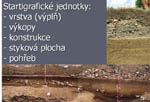
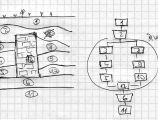
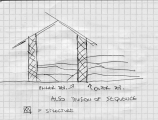
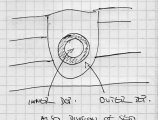

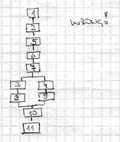
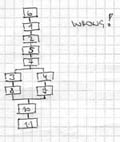

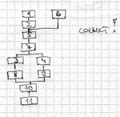
It’s a mammoth playground built of mountains, hills, lakes, rivers, valleys, woodlands,and beaches. eedebbebbeak